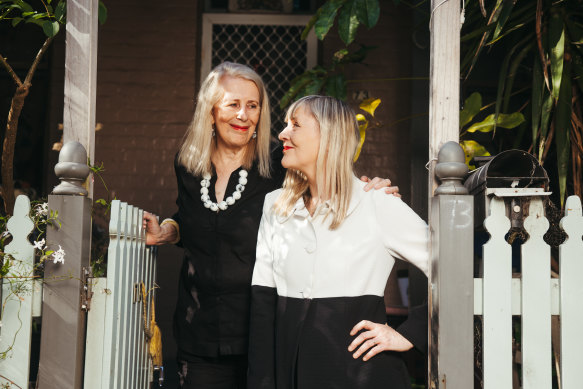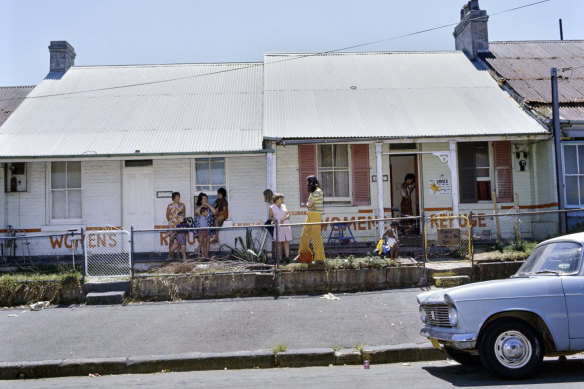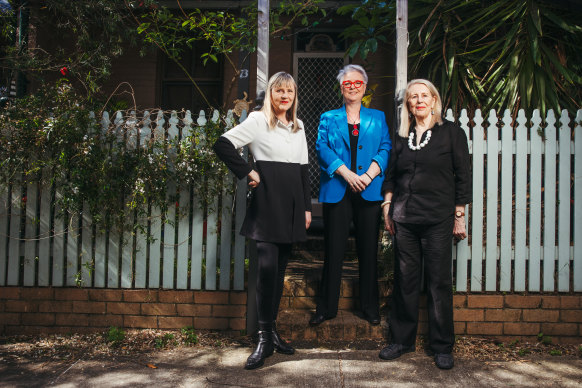Mandy Sayer and her mother endured three years of abuse at the hands of her stepfather until, on a stormy night in 1977, amid another violent rage, they fled.
Sayer, her mum and her baby brother ran out into the rain where, wearing their pyjamas, they hailed a taxi and asked to go to Glebe. Days earlier, Sayer’s mother had read about a women’s shelter there. The trio arrived at 2am wet, traumatised and weeping.
“The women took us in, paid the cab driver, dried us off, gave us clothes and food, and looked after us for about six weeks until we could move into another home,” Sayer says. “It was just an absolute oasis after three years of hell.”

Elsie founder Anne Summers, left, and childhood resident Mandy Sayer outside the former refuge.Credit: Dion Georgopoulos
That oasis was called Elsie Women’s Refuge. It was founded only three years earlier by a group of feminist activists who took over two abandoned neighbouring houses on Westmoreland Street and turned them into a safe place for women and children escaping domestic violence.
The refuge – the first of its kind in Australia – marked its 50th anniversary in March, and now it has been added to the State Heritage Register in recognition of its impact on the lives of women and children, and its connection to women’s activism in Sydney.
NSW Heritage Minister Penny Sharpe said Elsie had a lasting legacy of women creating safe places for other women. “It stands as a testament to the thousands of lives it has protected and changed, and the bravery, tenacity and vision of the women who founded it,” she said.

The Elsie Women’s Refuge in March 1974.Credit: National Archives of Australia
“It is an important piece of Australia’s social history, and the formal recognition ensures that this feminist story, and the stories of those it sheltered, will continue to be told.”
In the days after an anniversary conference, the Elsie Conference, on domestic violence in March, one of the refuge’s founders, writer Anne Summers, missed an email seeking her opinion on the proposed heritage listing. So it came as a surprise when she later received a call from Sharpe informing her that Elsie’s heritage status had been declared.
“I’m incredibly proud,” Summers says.
She is especially taken by a quote written by Catie Gilchrist for the Dictionary of Sydney that will be inscribed on a plaque outside the house: “Armed only with broomsticks, shovels and energetic determination, they changed the locks to establish residency and claimed squatter’s rights. On that day, 16 March 1974 the women declared Elsie Women’s Refuge Night Shelter open as Australia’s first emergency safe haven for women and children subject to domestic violence.”
Federal MP for Sydney Tanya Plibersek said the heritage listing was a fitting acknowledgement of a place and a movement that showed how far Australia had come, noting some parliamentarians at the time complained women’s shelters would “break up families”.
Summers was among six women who founded Elsie as squatters, including Bessie Guthrie and Jennifer Dakers. They had tried to open a refuge through more orthodox means, and even spoke with developers, but nothing seemed suitable and they didn’t have any money.
“So we just took one,” Summers says “We broke into a house in Glebe – we knew it was empty. We just smashed a window, got in there changed the locks and established squatters’ rights. Then we realised the house next door was empty, so we grabbed that one too.”
Like many other vacant houses around Sydney at the time, the two Glebe properties, Elsie and Minnie, had been slated for demolition by the Askin government but were subject to the union movement’s green bans.

From left: Mandy Sayer, Environment Minister Penny Sharpe, and Elsie founder Anne Summers.Credit: Dion Georgopoulos
Then-social security minister Bill Hayden visited Elsie, leading the Whitlam government to provide a one-off grant, and the refuge moved to larger premises in Glebe. By mid-1975 there were 11 shelters established nationally – today there are more than 800.
Summers and Sayer are dismayed to see violence against women getting worse, not better. They point to technology enabling men to find new ways to intimidate and abuse women, and laws that have not kept pace.
“Coercive control has always existed even though we didn’t have that name for it,” says Summers. “The guys that indulge in it have become a lot more cunning and a lot more creative. It’s terrible – governments are certainly acknowledging it, [but] I don’t think they’re doing enough.”
Sayer, who is an award-winning novelist and non-fiction writer, says the Elsie Women’s Refuge not only saved her life – it transformed it. “I was a 14-year-old girl sitting around reading all the feminist literature in the library,” she says. “It was a marvellous education.”
Support is available from the National Sexual Assault, Domestic Family Violence
Counselling Service at 1800RESPECT (1800 737 732).
Start the day with a summary of the day’s most important and interesting stories, analysis and insights. Sign up for our Morning Edition newsletter.